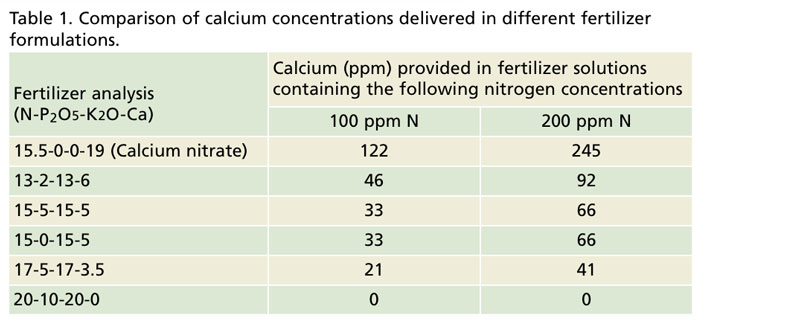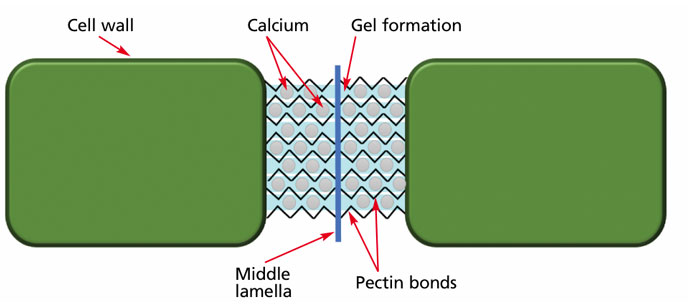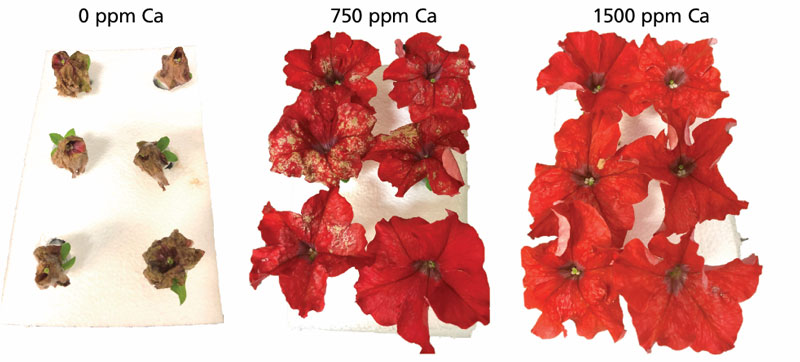9/1/2019
Stronger Plants
Katherine Bennett & James E. Faust

Our initial work on poinsettias and geraniums showed that spray applications of calcium increased leaf strength of unrooted cuttings. Leaf strength was measured by using a gauge to record the force required to puncture a leaf.
Calcium chloride was the source of calcium and application rates were as high as 800 ppm. These results have implications for stock plant production for increasing plant tolerance to mechanical stresses that occur during cutting harvest, packaging, shipping and propagation. Growers can likely envision additional applications for this technique on other crops where physical damage creates production problems or where “soft” tissues result in the breakdown and decay of plant tissues.
Supplying calcium through the fertilizer solution
The two main techniques used to supply calcium to plants are: 1) drench applications with a fertigation solution applied to the growing media; or 2) spray applications applied directly to above-ground tissues. Fertigation is most effective at supplying calcium to leaves. For example, petunia leaves increased from 2.2% to 3.5% calcium (a 55% increase) as the calcium concentration applied in the fertigation solution increased from 0 to 200 ppm, while the concentration of calcium in the flower petals wasn’t affected by the fertigation solutions.
Our challenge is that pre-blended fertilizers often have relatively low concentrations of calcium (<100 ppm) and the calcium concentrations are tied to the nitrogen concentration to be delivered (Table 1). Applying fertilizer solutions consisting of 200 to 250 ppm N used to be quite common, but nowadays growers are applying only 100 to 150 ppm N to many crops. A 250 ppm N solution of a 15-5-15 fertilizer supplies 83 ppm Ca, while a 100 ppm N solution of the same fertilizer supplies only 33 ppm Ca. Additionally, some growers are taking the starter charge out of their growing media, which may have contained calcium nitrate or gypsum (calcium sulfate) previously incorporated into the media prior to planting.
 The bottom line is the amount of calcium can be quite low in many fertigation programs, so a second fertilizer is likely to be needed to apply >100 ppm calcium through the fertigation solution. Calcium chloride is a common choice for applying additional calcium, however, the electrical conductivity (EC) of the solution can become quite high (<2.0 mmhos/cm). High EC solutions can reduce plant growth and can damage roots, so this is often the main factor limiting how much calcium can be added to a fertilizer solution. For this reason, spray applications may be a better method to improve tissue concentrations, especially for flowers and fruits.
The bottom line is the amount of calcium can be quite low in many fertigation programs, so a second fertilizer is likely to be needed to apply >100 ppm calcium through the fertigation solution. Calcium chloride is a common choice for applying additional calcium, however, the electrical conductivity (EC) of the solution can become quite high (<2.0 mmhos/cm). High EC solutions can reduce plant growth and can damage roots, so this is often the main factor limiting how much calcium can be added to a fertilizer solution. For this reason, spray applications may be a better method to improve tissue concentrations, especially for flowers and fruits.
It’s useful to note that hydroponic fertilizer solutions often supply up to 200 ppm Ca. This is more easily accomplished in hydroponic production than in container production because the plants never experience drought stress in hydroponic situations, so the high EC solutions are less likely to damage the plants.
Supplying calcium though spray solutions
Our data show that the calcium concentration in petunia flower petals increased from 0.26% to 0.65% as spray applications of calcium increased from 0 to 1,500 ppm. Note that the calcium concentrations in flower petals is one-tenth of the concentration in the leaves. Flower petals transpire much less  water than leaves because the petals lack stomata because they’re not doing photosynthesis. As a consequence, much less calcium is transported to the petals than to the leaves. We believe this is one of the main reasons that flower petals are so much more susceptible to Botrytis infection than leaves.
water than leaves because the petals lack stomata because they’re not doing photosynthesis. As a consequence, much less calcium is transported to the petals than to the leaves. We believe this is one of the main reasons that flower petals are so much more susceptible to Botrytis infection than leaves.
Figure 1. Illustration of how calcium stabilizes intercellar spaces. As calcium levels increase, calcium is interlaced within a pectin matrix and gel formation occurs, which acts to cement the cells together. This process strengthens the tissue resistance to mechanical stresses and Botrytis infection.
Spray applications can be performed weekly so that newly developing tissues are always being treated. If the goal is to protect flower tissue, then sprays should begin as flower buds become visible. Wetting agents, or adjuvants, can improve contact of the spray solution and the plant tissue. The material cost of calcium spray applications is often extremely low and calcium solutions can often be tank mixed with other products to save time and labor, but experimentation should always be performed to ensure that no detrimental results will occur. (Further details on mixing and applying calcium solutions will be provided in next month’s article.)
 Botrytis cinerea
Botrytis cinerea: plant pathogen
Botrytis infection begins when a spore lands on a susceptible host and a germ tube emerges from the spore, much like the first stage of seed germination. Germination of Botrytis spores is optimal during extended periods of high humidity (>94%) and moderate temperature (65 to 75F/18 to 23C). However, Botrytis is able to germinate and cause infection in more extreme temperatures, albeit at a slower rate of infection.
Figure 2. Increasing calcium concentration in the weekly spray application from 0 to 1500 ppm Ca reduces Botrytis infection of petunia flowers.
Once the germ tube is created, the fungus then begins to secrete an enzyme that facilitates the breakdown of the cell wall so that the fungus can use the contents of the cell for its own survival and growth. Calcium can circumvent the infection process by creating a stronger cell wall that’s harder for Botrytis to invade.
Figure 1 shows how calcium binds with pectin in the intercellar spaces to create a cross-link matrix and a gel-like substance that effectively cements the cell walls together. By creating a physical barrier within the plant, it’s harder for fungus to reach its source of food inside the cells, causing the infection process to be significantly delayed. This results in leaves that are more resistant to mechanical stresses, as well as to Botrytis infection.
Calcium benefits from start to finish
During stock plant production, providing increased levels of calcium is beneficial for transport and during propagation of the cuttings. Propagation success starts before the cuttings even arrive. Once the cuttings are rooted, calcium can usually be supplied to plants in sufficient amounts via the fertigation solution during their vegetative growth phase. It’s just important to remember that the calcium concentration supplied in different fertilizers can be very different depending on the nitrogen concentration chosen and the fertilizer used (Table 1).
Plants become more susceptible to Botrytis infection when flowering begins and the fertigation solution doesn’t supply adequate calcium to the rapidly expanding petal tissue. Our experimentation has demonstrated that calcium concentrations of 750 to 1,500 ppm can dramatically reduce the rate of Botrytis infection on flower petal tissue (Figure 2). Weekly spray applications during flower bud development are suggested.
We’ve occasionally observed small amounts of phytotoxicity at high rates (>1,000 ppm Ca), so you need to test-spray whatever species and varieties you want to use this technique on before applying it to the entire crop. GT
Acknowledgements: The American Floral Endowment and the Floriculture Research Alliance support our research efforts exploring practical techniques to improve cutting quality and Botrytis management.
Katherine Bennett recently completed her M.S. degree at Clemson University and is currently a Research Scientist at Metrolina Greenhouses. James Faust is an Associate Professor at Clemson University.